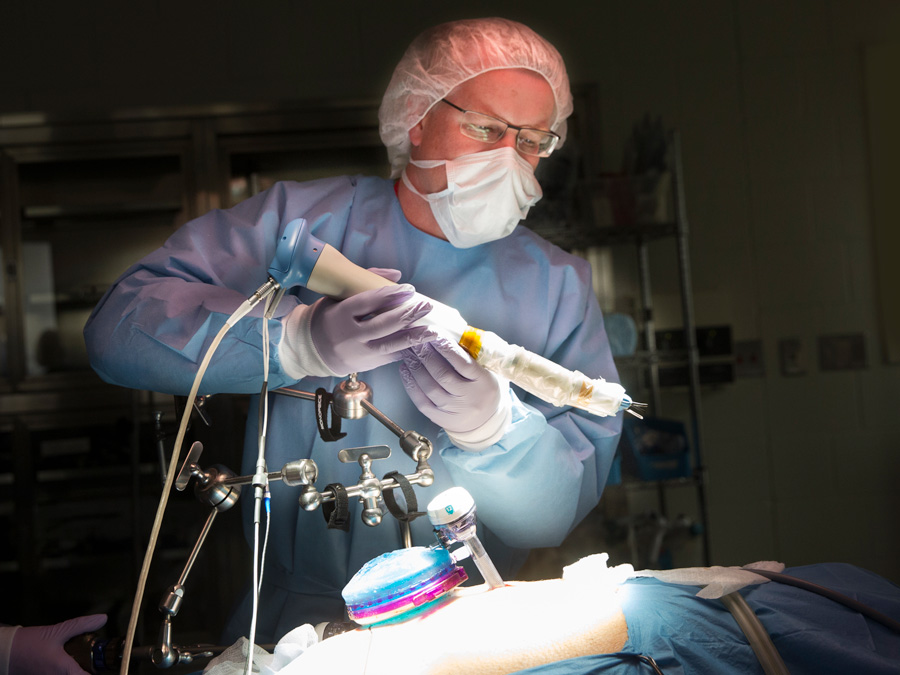How a UNL Medtech Startup is Transforming Abdominal Surgery
By Jackie Ostrowicki
March 2022
More than 400,000 Americans need colon resection procedures each year to treat lower gastrointestinal diseases such as diverticulitis, colon polyps, pre-cancerous and cancerous colon lesions and inflammatory bowel disease. Right now, the most common approach to colorectal procedures is open surgery—which requires a large incision, a lengthy hospital stay and several weeks of recovery, as well as a high risk of infection and other complications.
All that could change with Virtual Incision, a medical device company cofounded by University of Nebraska–Lincoln engineering professor Shane Farritor. He is working to transform abdominal surgeries with a miniaturized, first-of-its-kind surgical robot, MIRA.
Surgical Robots: The Wave of the Future
Farritor, an engineer and inventor, has received significant funding from NASA and the Army to do research on robotic surgery. He's been building surgical robots ever since. When a clear clinical application for his research was seen a decade ago, Farritor received several rounds of investment to keep pushing it forward—including the most recent investment of $46 million in November of 2021.

Two clinical trials were conducted in South America in 2016, which helped the Virtual Incision team implement changes and paved the way for their latest milestone. The Food and Drug Administration greenlighted a clinical study of the robotic platform, which will be carried out at a limited number of U.S. hospitals—including Bryan Medical Center in Lincoln, Neb., where the robotic assistant was used in its first human surgery in early 2021. Successful completion of the trial is a critical step toward FDA approval of the device, after which hospitals could begin using it widely.
MIRA, which stands for "miniaturized in vivo robotic assistant," weighs only 2 pounds and can easily be moved from surgical room to surgical room in a hospital, maximizing surgical space and increasing the number of surgeries that can be performed. It can perform minimally invasive procedures—with a patient recovery time of days rather than months.
Lowering Costs and Improving Outcomes
Other companies have also developed surgical robots, but their devices are large and expensive—some costing up to two million dollars. They are used from the outside of the body and come with limitations. MIRA is a new class of device, as it is inserted into the body. Its small size makes it more accessible and cost-effective for hospitals, which would allow more patients to benefit.
"Demand for robotically-assisted surgery is increasing; it leads to improved patient outcomes and lower costs," said Farritor. "We're excited to start our clinical study and bring the platform one step closer to helping patients who are facing abdominal surgery."
"The specific device we're testing is for colon resections, so there's plenty of room to grow. We envision different robots for different procedures—a robot for hernia, one for gallbladders. There are many opportunities for new product lines."
Farritor has a big vision for Virtual Incision. "The specific device we are testing is for colon resections, so there's plenty of room to grow. We envision different robots for different procedures—a robot for hernia, one for gallbladders. There are many opportunities for new product lines as the company develops. I consider it developing the right surgical devices for the right job, versus a one-size-fits all approach."
Thinking Outside the Box
When it comes to inventing, Farritor is right at home. He is a Fellow of the National Academy of Inventors and a maker at heart. Farritor's portfolio spans new research (adding artificial intelligence to robotic surgery) to enabling non-classroom experience for students (he has placed interns at NASA, where he previously worked). It also includes institutional planning—he was involved in N2025, UNL's latest strategic plan, as a co-chair.
He also chairs the board of advisors for Nebraska Innovation Studio, a membership-based maker space on UNL's Nebraska Innovation Campus. Virtual Incision uses the Innovation Studio to prototype and build fixtures that support their robotic development, and Farritor is teaching a class in the studio this semester, ‘Building through Innovation.' "You need to build things to solve problems; get your hands involved," he said.
How does that philosophy lead to innovations such as surgical robots? "Making things pushes you to experiment. You know how people say measure twice, cut once? That's terrible advice," Farritor said. "I say don't measure and cut twice. Boards are cheap; cut a few. Push your thinking and make your own path."
Discover our Podcast Series
The “Leading Nebraska” podcast shares the stories of the researchers, students, teachers and others across the University of Nebraska's four campuses who are making an impact. From teachers and doctors to engineers and ag experts, these Nebraska leaders are touching lives and making a difference.